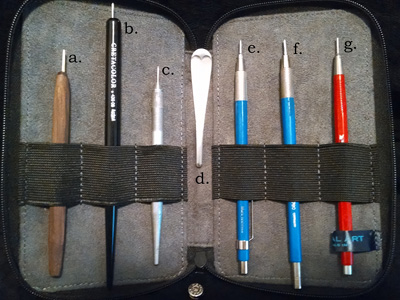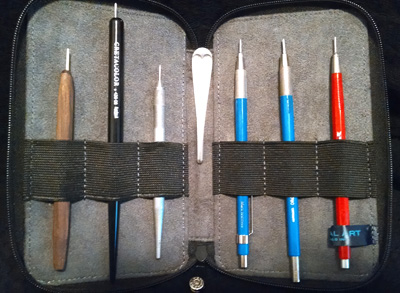|
Silverpoint Drawings:
Animals
Botanical
Shells
People
Still Life
What is Silverpoint?
Various Illustrations:
Color Pencil
Graphite
Pointillism
Watercolor Art:
Animals
Botanical
Sculptures:
Colorado Yule Marble
'Fencepost' Limestone
Minnesota Pipestone
New Mexico Sandstone
About Stone Carving
Fine Metal
|
What is
Silverpoint or Metalpoint drawing medium?
|
Silverpoint is a unique
and ancient drawing medium rarely practiced today except by
a couple of hundred artists in the entire world.
Metalpoint drawing is not an easy or forgiving art medium
since once a drawing mark is made on the drawing surface, it
cannot be erased - so any errors in the drawing are
permanent!
A Brief History of Metalpoint
illustration:
Metalpoint was initially used as a drawing and writing medium
that dates from antiquity and was particularly popular from the 14th
century to the beginning of the 16th by artists such as Leonardo da
Vinci, Sandro Botticelli, Fra Filippo Lippi, and Albrecht Dürer.
With the Renaissance period, came new artists materials such as
graphite (for pencils) that were much easier for artists to use and
transport, so the ‘art’ of metalpoint drawing began to disappear in
the 16th century and only received a mild interest in the late 1800s
by a few Impressionist artists. |
Tools and Styli
 |
This inflexibility of this medium makes metalpoint most appropriate
for small, detailed compositions depicting still objects. It is less
effective when depicting movement or for quick, loose sketching,
which requires a free-flowing stroke. A technique to add tonal range
to metalpoint drawings became popular in the early Renaissance, as
interest in three-dimensional imagery grew.
Using metalpoint on a toned ground and adding white highlights
renders a ‘chiaroscuro’ effect. The ground provides the middle of
the tonal range, and the highlights create greater contrast against
the darker strokes of the metalpoint. (Source 1)
The silverpoint technique refers to using a soft metal stylus
(usually of .999 pure soft silver) to create the illustration.
However bronze, copper and gold wire are also used for styli, hence
the true name as Metalpoint. Although other metals might be used,
any metalpoint drawing is often just commonly called Silverpoint.
(See the photo of my metalpoint styli I have either purchased or
hand-made for myself).
The fine-tipped metal stylus allows the artist to design with very
fine lines of a pale-gray color – similar to a graphite pencil on a
suitably prepared drawing surface. The drawing surface is coated
with a prepared liquid called “drawing ground” which when dry, has a
very fine abrasive surface.
The drawing ground was a prepared liquid containing rabbit hide glue
or some other adhesive property combined with fine bone or marble
dust and other elements, painted on a substrate surface such of as
heavy paper, wood panel or even parchment in ancient times.
After the drawing is completed, the rendered silver-gray lines on
the surface will oxidize or tarnish after a few years (sometimes in
10 or 20 years) and retain a subtle but fine, warm sepia-tone to the
drawing. Great care and a fine, light touch is necessary to draw
with a metalpoint stylus.
Metal styli of bronze & copper drawings are lighter in color which
will oxidize with a greenish-gold hue after several years. Gold
metalpoint drawings retain the fine pale-gray color since gold does
not tarnish.
Although silverpoint drawing can be a difficult and unforgiving
medium, the metalpoint produces a particularly fine and delicate
mark, making it a desirable tool for the highly skilled draftsman.
Metalpoint drawings require careful handling and special storage
conditions because their surfaces are fragile and easily blemished.
(Source 2)
Today, only a few artists still prepare their own drawing ground
using traditional methods. Commercial drawing ground liquids are
available now, which I find easier and more convenient to use.
Only recently in the 1980s and into the 21st century, has this
ancient art medium regained a new revival and popularity among a
small group of dedicated and highly skilled artists such as Tom
Mazzullo, Laura Schechter, Norine Kevolic, David Boles, Anita
Chowdry, Gerrit Verstraete, Andrew Gott, Victor Koulbak and several
other Metalpoint Artists today. You may see a variety of Metalpoint
art on
http://metalpointartists.com/gallery.html - the website for The
Society of Metalpoint Artists.
In my art experience, I was peripherally aware of the silverpoint
drawing medium, but I didn’t know much about it until December 2013.
While visiting the Denver Art Museum, I saw some exquisite,
contemporary silverpoint drawings by D.U. Art Professor Tom Mazzullo
while he was giving demonstrations of this ancient drawing medium.
Meeting with Tom has provided me a great interest in this art
medium. Tom Mazzullo has also been very kind, generous guide,
offering me friendly advice as well as providing me with
inspiration, valuable critique and help in working with silverpoint
as an art medium. I honor Mr. Tom Mazzullo for his invaluable
assistance. You may see Tom’s silverpoint illustrations on
http://www.tommazzullo.com/
The technique of metalpoint
drawing involves:
1. Preparing the drawing ‘ground’ liquid - which can be gesso or
casein paint, commercially prepared silverpoint ground or if you are
industrious and adventurous, ancient & traditional ground
ingredients can be prepared by suitable instructions on the web. The
‘ground liquid’ is applied to your drawing surface. I use watercolor
paper of 140 lb. or 300 lb. hot press as recommended by artist Tom
Mazzullo. I prep the watercolor paper as I would for any watercolor
painting by taping it to a hardwood board, and with a damp towel,
wet the paper to stretch it. After this initial stretching, the
ground liquid is applied to the watercolor paper. Allowed to dry and
then another coat is applied – usually two or three coats.
2. For ground, I also use either
Golden’s® brand Silverpoint drawing ground or (as mentioned), white
casein paint which was introduced to me by artist Tom Mazzullo. I’ve
found that in using Golden’s® brand Silverpoint drawing ground –
you should shake it well before applying it because if not – it
takes too long to dry, is sticky and does not always provide a good
surface to draw on – so, shake well before using! Either material
can be tinted with a small amount of watercolor paint such as light
tan, yellow, pink, blue or green.
| 3. For metal
styli, I have two commercially made silverpoint styli, but
also have made my own silverpoint styli using .999 pure,
soft silver. I have also made my own copper & bronze styli
with a wood or metal stylus holder.
4. As the metal stylus tip is
drawn on the surface, tiny particles of metal are left
behind, creating a mark on the finely abrasive coating of
the painted ground on the drawing surface.
5. Some Silverpoint artists advise
that a drawing the size of 8 inches by 10 inches (approx. 20 cm X 26
cm.) can take 8 to 200 hours to complete a single drawing, depending
on the subject and detail of the drawing. |
 |
Conclusion
All types of metalpoint appear gray when first drawn (including gold
and copper) and light metals such as silver produce a mark that is
darker in value than the solid metal. As the metals are exposed to
the air, they begin to tarnish, or oxidize, producing corrosion
products that alter their appearance. Color changes vary according
to metal composition, air quality, exposure to light, and the
grounds they are applied to.
Metalpoint is an intriguing, though often forgotten, art form
that holds an important place in the history of art. Its unique
aesthetic qualities and challenging technical requirements make it a
highly respected and cherished drawing medium. The materials and
structure that create these characteristics render most standard
conservation treatments inappropriate. The preservation measures of
controlling storage and handling conditions are the best means of
ensuring that this unique and fascinating medium continues to
survive (Source 2).
Historical notes & conclusion - Source cited:
1.
Silverpoint
Drawing Complete,
http://silverpointweb.com/
2. BigaBytes Painters Studio: Artist
Materials and Techniques,
http://paintersstudio.com/drawing/metalpoint.php
return to top
|